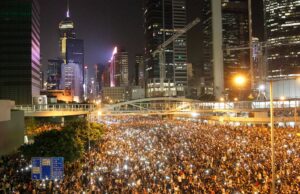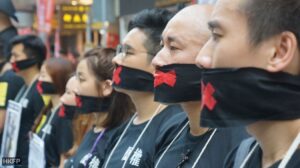Angelica B

Occupy Central Protest of 2014. Photo by Dickson Lee of South China Morning Post.
Before we dive in, I think it’s important to provide some background information on Hong Kong. Hong Kong is a small region on the southeast tip of China with a population of 7.4 million, making it the fourth most densely populated place in the world. Hong Kong is a former British colony that was handed back to China in 1997 under the agreement that Hong Kong would maintain a “high degree of autonomy, except in foreign and defence affairs” (“The Joint Declaration”). As many people expected, this “autonomy” did not last. China has been incessantly enforcing their control over Hong Kong in a multitude of ways, with the British Chairman of Foreign affairs saying China has been treating the pre-handover agreement signed between China and the United Kingdom as “void” (“Daily Hansard – Debate”). Hong Kong citizens have protested Chinese control several times since the handover, most famously during the Umbrella Revolution protests of 2014. The revolt of Hong Kong citizens has the potential to create dire consequences for China as it could inspire mainland Chinese citizens to follow suit. This has led to increased tension between Hong Kong citizens and the Hong Kong government who has been trying to suppress any resistance to China.
As you can imagine, standing up to one of the most powerful countries in the world is not simply done. Many media companies are owned either by Chinese citizens or by people who have “heavy business interests in the mainland” (Lee 10) and were therefore easily manipulated into censoring the output of their companies in the interests of the Chinese government. Censorship of newspapers has been implemented at all levels by the Chinese government from bribing individual journalists, to banning certain newspapers from government press meetings, to ownership of newspapers. The Chinese government has not refrained from using harsh punishments to make examples out of people and increase self censorship. Undeterred, the newspaper Apple Daily has soared in popularity by appealing to the pro-democracy protestors and providing criticisms of the Chinese government to an extent that no other newspapers were willing to go to.
Apple Daily began as a daily newspaper in 1995 and has since launched a website, an app for mobile phones, and a YouTube channel. Apple Daily has become the most visited online news portal in Hong Kong, with more than 45 million views per day on their online outlets (Yeung). Apple Daily is known for its support of pro-democracy protestors and open criticisms of the Chinese government. During a 2004 protest, a survey found that 50% of the participants were readers of Apple Daily (Lee and Lin 335).

Protest outside the home of Apple Daily owner Jimmy Lai. The sign on the right criticizes Lai for secretly donating money in support of the Umbrella Revolution, and says that the revolution is an American plan by the CIA to ruin Hong Kong. Photo by Ming Wai So of Oriental Daily, 2016.
The more Apple Daily has shown its support for democracy in Hong Kong, the more backlash the newspaper has received. During the Umbrella Revolution in 2014, Apple Daily faced an unprecedented amount of backlash. Their website became the target for “the largest cyber attack in history” (Tsui 451) with a DDoS, or distributed denial of service attack, of 500gb of traffic per second, which shut down the website and made it completely inaccessible. The attack also served another purpose, which was to increase running costs for Apple Daily, making it harder to keep the paper running (Tsui 451). To make matters worse, Chinese-controlled businesses were also strongly encouraged to remove all advertisements from newspapers that the Chinese government didn’t approve of, including Apple Daily. Pro-Beijing protestors created a blockade around Apple Daily headquarters for days during the Umbrella Revolution, preventing the newspaper’s delivery trucks from leaving. Copies of Apple Daily that pro-Beijing protestors were able to get a hold of were promptly destroyed. Between the house of Apple Daily owner Jimmy Lai and the headquarters of Apple Daily, there have been as many as 108 protests during a 6 month period (Ng, “Court Bans Pro-Beijing Protestors”). The Chief Executive of Hong Kong, the head of the government, has even threatened Apple Daily with legal action after they published an article alleging that he had secretly accepted money from a foreign company (Ng, “CY Leung Denies Legal Threats”).
In an environment where someone can and has been arrested just for having “access to a computer with criminal or dishonest intent”, and people must accept the risk of being forcibly disappeared should they criticize the government, Apple Daily’s resistance to the Chinese government is crucial to maintaining not only press freedom in Hong Kong but also in keeping the hope for universal suffrage alive (Tsui 450).

Photo from the annual July 1 protest on the anniversary of the handover. Photo by Tom Grundy of Hong Kong Free Press, 2018.
Works Cited
“Daily Hansard – Debate.” Publications of UK Parliament, 2 December 2014, Column 164. publications.parliament.uk/pa/cm201415/cmhansrd/cm141202/debtext/1412020001.htm#14120247000001. Accessed 5 February 2019.
Grundy, Tom. “In Pictures.” Hong Kong Free Press, 1 July 2018. www.hongkongfp.com/2018/07/01/pictures-end-one-party-dictatorship-50000-join-march-democracy-hong-kong-say-organisers/. Accessed 5 February 2019.
Lee, Dickson. “Night Had Fallen but Occupy Central Continued, with Lights from Thousands of Protestors Stretching as Far as the Eye Can See.” South China Morning Post. 30 September 2014. www.scmp.com/news/hong-kong/article/1604461/top-10-moments- occupy-central-so-far. Accessed 5 February 2019.
Lee, Francis L. F. “Changing Political Economy of the Hong Kong Media.” China Perspectives, 2018/3, 2018, pp. 9-18
Lee, Francis L. F. and Angel M.Y. Lin. “Newspaper Editorial Discourse and the Politics of Self-Censorship in Hong Kong” Discourse & Society, vol. 17, no. 3, 2006, pp. 331-358.
Ng, Ellie. “Court Bans Pro-Beijing Protestors from Harassing, and Blocking Home of Media Tycoon Jimmy Lai.” Hong Kong Free Press, 7 December 2016, www.hongkongfp.com/2016/12/07/court-bans-pro-beijing-protesters-from-causing-harassment-blocking-home-of-media-tycoon-jimmy-lai/. Accessed 3 February 2019.
Ng, Ellie. “Cy Leung Denies his Legal Threats Against Apple Daily Affect Hong Kong’s Press Freedom.” Hong Kong Free Press, 4 October 2016, www.hongkongfp.com/2016/10/04/cy-leung-denies-his-legal-threats-against-apple-daily-affect-hong-kongs-press-freedom/. Accessed 5 February 2019.
So, Ming Wai. Oriental Daily News, 4 November 2016. hk.on.cc/hk/bkn/cnt/news/20161104/bkn-201611041220304241104_00822_001.html? fbclid=IwAR2mVCS1wFIsiuBAQdW6Mj21ZUXSv0MNWrHwv8bGgJ97vmJfF8ujCRLnro. Accessed 5 February 2019.
“The Joint Declaration.” Constitutional and Mainland Affairs Bureau. Revised 1 July 2007, The Government of the Hong Kong Special Administrative Region, 2005, www.cmab.gov.hk/en/issues/jd2.htm. Accessed 3 February 2019.
Tsui, Lokman. “The Coming Colonization of Hong Kong Cyberspace: Government Responses to the Use of New Technologies by the Umbrella Movement.” Chinese Journal of Communication, vol. 8, no. 4, 2015, pp. 447-455.
Yeung, SC. “Why Next Digital is Raising the Price of Apple Daily.” Ejinsight, 28 December 2018. www.ejinsight.com/20181228-why-next-digital-is-raising-the-price-of-apple-daily/. Accessed 11 February 2019.